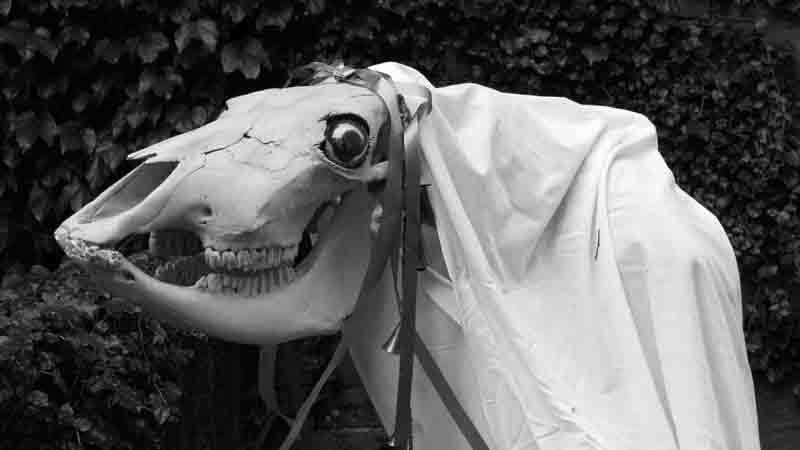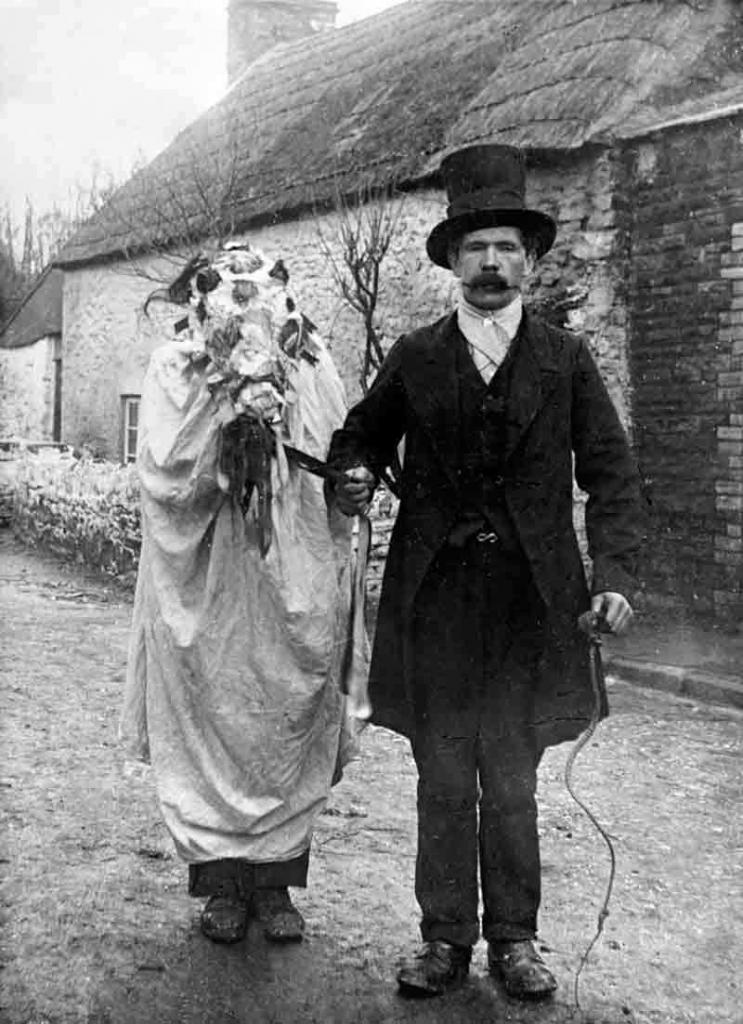The Mari Lwyd Christmas tradition in Wales sees locals carrying a decorated horse skulls, says CLAIRE BARRAND

In Wales at Christmas and New Year, there used to be one custom that first began in 1800.
Known most commonly as the Mari Lwyd, (in Welsh, Y Fari Lwyd) the name is debated.
Some believe it to mean “Mary, Mother of Jesus”, others “Holy Mary”, or “Grey Mare”, but it is thought likely that it is a pre-Christian Pagan tradition.
The Mari Lwyd is a horse skull, which is mounted onto a pole rather like a hobby horse, and draped in a sackcloth and ribbons.
Sometimes the horse skull was fixed to be able to open and close its jaw, and it often had glass eyes in the sockets.
Decorating the Mari Lwyd would be a part of the custom, with the community getting involved.
It represents the hooded animal that is seen throughout folklore tales from around the UK and this one is specific to South Wales.
In one area of the Gower, they would bury the skull throughout the year and only dig it up for use at Christmas.
Traditionally a group of men would carry the Mari Lwyd through villages and towns, singing a song asking for people to let them into their homes.
Householders were expected to deny them access using a song, poetry, and rhymes in return and if they managed to gain entry into a house they would be rewarded with food and drink.
This custom would be performed over the course of several days, each time lasting well into the night, so there wasn’t one day that was customary, as long as it was around the Christmas or New Year period.
The men would also wear costumes, they might look a little bit like Punch and Judy characters, with blackened faces, and wearing colorful ribbons and rosettes.
The leader would carry a staff or whip and there would be a Merryman playing a musical instrument, so you can imagine they created quite a noise as they marched along.
They would make the Mari Lwyd mock chase people around and pretend to try to restrain it which was all part of the entertainment factor!
The reasons why this custom was performed is also subject to debate.
What is the origins of Mari Lwyd?
At this time of year, there were many festivals that reflected the season’s dark nights coming to an end and the coming of spring.
Birth and Death has a strong meaning, and a dead horse coming back to life perhaps represented this.
In Celtic Britain, the horse was a prized symbol.
A sign of fertility, horses had a strong presence on battlefields, and they were a protector.
It was very much believed that the care you took of your horse would be reciprocated.
Many Celtic Gods were associated with the horse too.

In mythology, animals that could cross from the underworld to ours would be white or grey. The Mari Lwyd is grey.
In Welsh mythology, Queen of the Underworld, Rhiannon, first appears riding a large white horse during the first branch of the Mabinogian.
In another Welsh mythological tale, the Ceffyl Dwr was a water horse said to inhabit waterfalls and pools, and the Pwca, a fairy figure was able to shapeshift into the form of a horse.
There were many horse ghost stories too, the headless horseman and the spectre of the horse and carriage were often reported around Wales by terrified travelers.
White horses are also the most common type of hill figure in the UK.
Carleon under from seige
In my own research, I found an interesting article that was published in the Monmouthshire Merlin on 31st December 1864 by a man named Mr. Thomas Young of the New Inn, Risca, and he offered his own explanation as to the origins of the Mari Lwyd.
He wrote to say that during the 15th Century around Christmas time, the town of Carleon which is in Monmouthshire, was in danger of being besieged.
The enemy was in hiding in woodlands in Lady Hill, and St Julian’s respectively.
The castle there was situated at the end of a wooden bridge, and an army of people waited there ready for battle should they be ambushed.
Two days before Christmas, the lookout party witnessed a mysterious figure dressed in woman’s clothing, on a grey horse appear and start to cross the bridge, she was moving slowly, and they suspected her to be a spy.
It was very unusual for a woman to be out alone at night like this and when she stopped on the bridge, the sergeant stationed there decided to blow the horn and signaled his nine men to seize her.
One of the men grabbed the reins of the steed which reared up and the rider managed to dismount and disappeared over the bridge into the water below. Such was the darkness of the night; the moon was blocked by clouds they did not see where she went.
The angry party of men beheaded the poor horse and put its head onto a pole, to parade around the town exhibiting their victory in capturing a traitor, and they were rewarded with gifts and applause for their heroic actions.
They kept the skull of the horse and every year they dressed it up with leather ears, glass eyes, and ribbons, draping it in a sheet and from there grew the tradition of knocking on doors singing songs asking for admittance.
Other local towns and villages followed suit and from there the tradition evolved.
The tradition sadly died out in the late 1800s because the revelers began to get a bad reputation for drunkenness and rowdy behavior during the industrial revolution and people became discouraged to continue it.
But in recent years there have been several Welsh projects and folk associations keen to keep the tradition alive especially in schools, which I like, folklore is a part of Welsh history that should never be forgotten.







